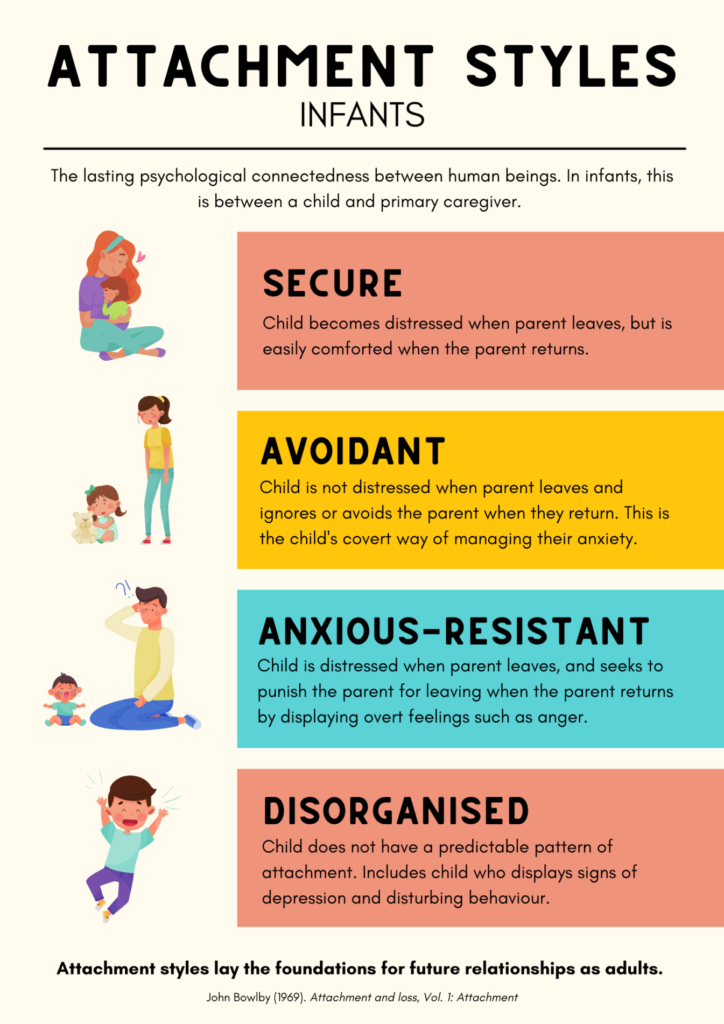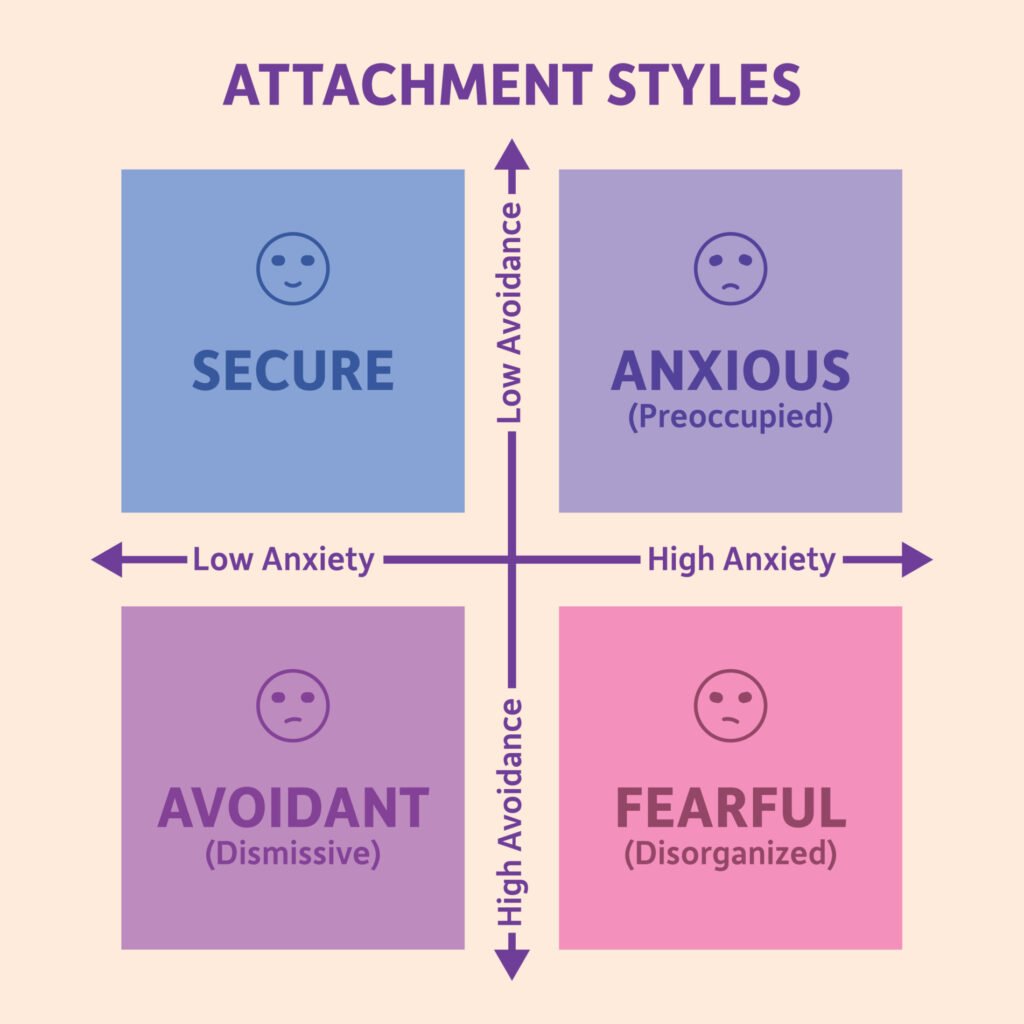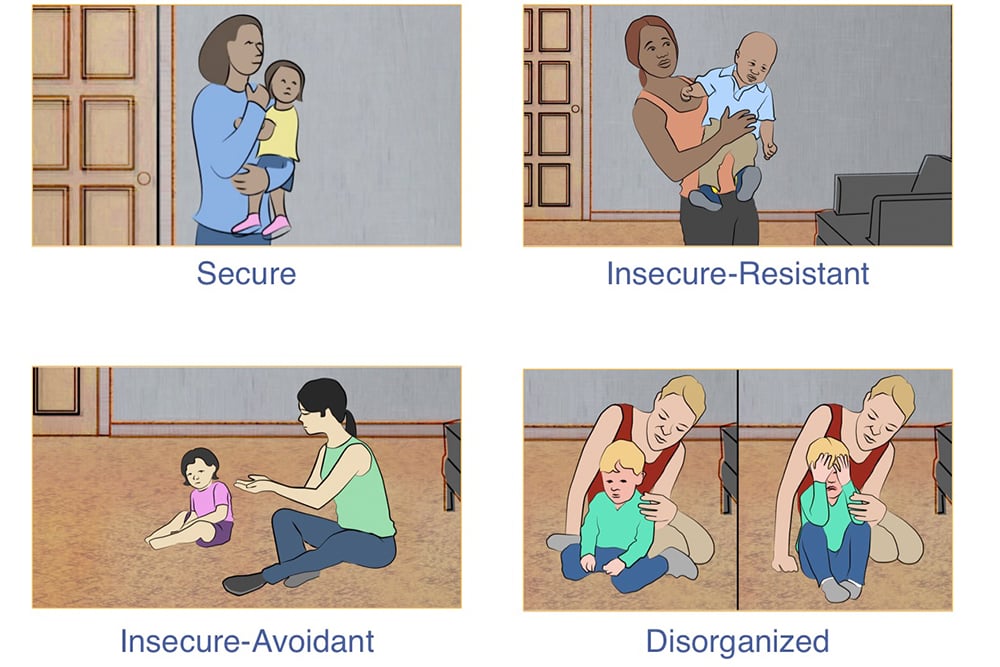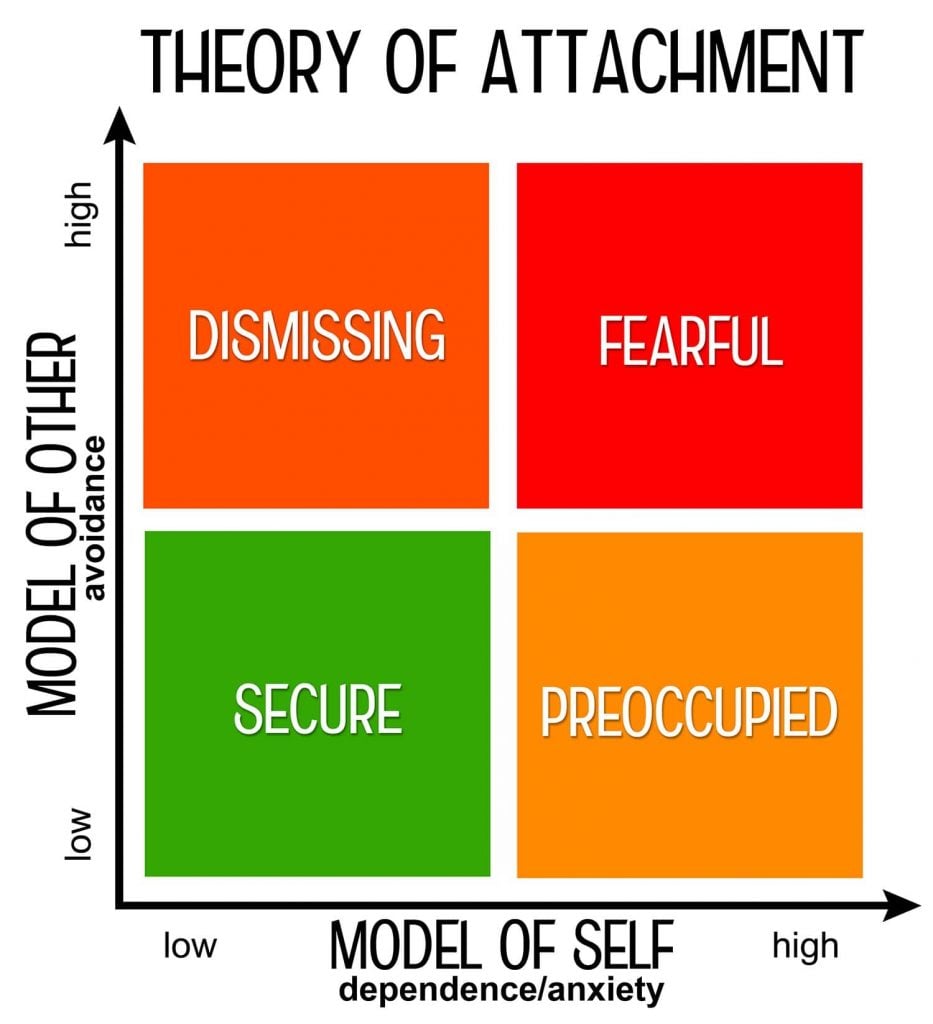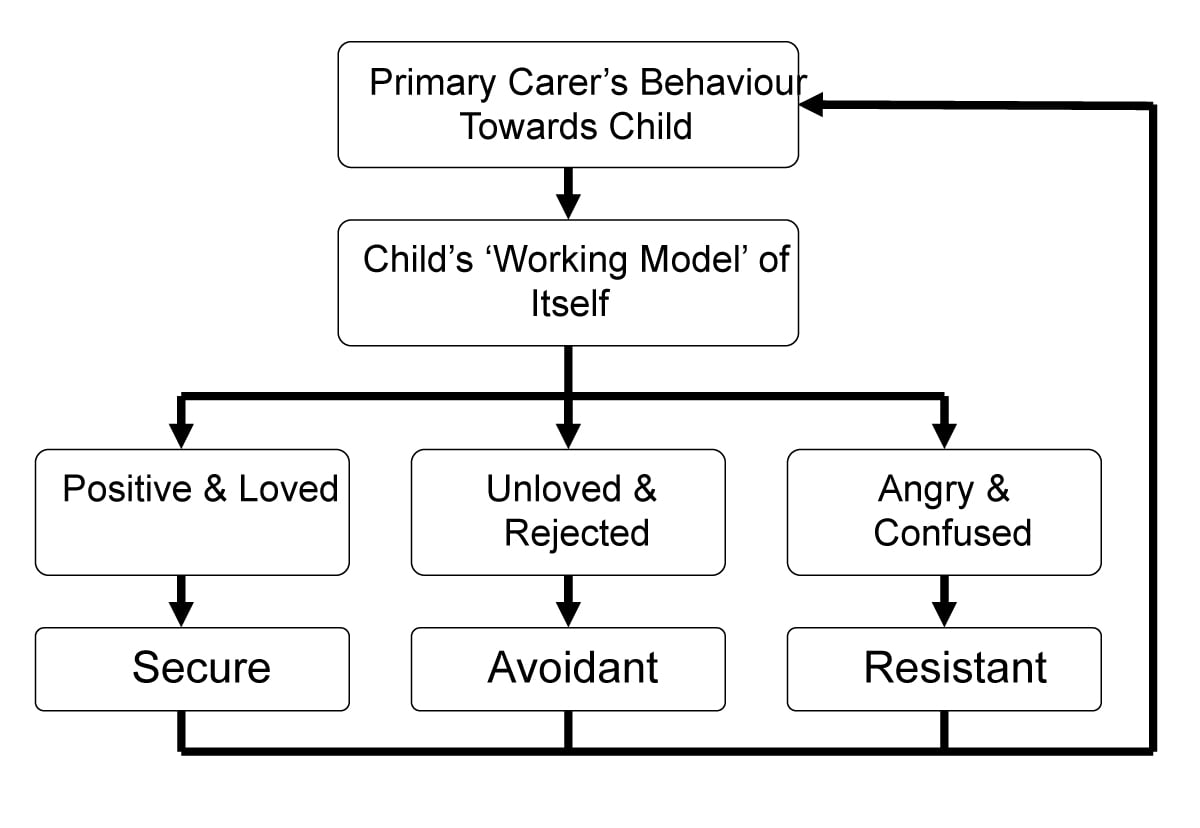On This Page:
Attachment styles refer to patterns of bonding that people learn as children and carry into their adult relationships. They’re typically thought to originate from the type of care one received in their earliest years.
The concept involves one’s confidence in the attachment figure’s availability as a secure base from which one can freely explore the world when not in distress and a safe haven from which one can seek support, protection, and comfort in times of distress.
What are the attachment styles?
- Secure Attachment: Securely attached individuals are comfortable with intimacy and can balance dependence and independence in relationships.
- Preoccupied Attachment (Anxious in Children): Individuals with this attachment style crave intimacy and can be overly dependent and demanding in relationships.
- Dismissive Attachment (Avoidant in Children): This style is characterized by a strong sense of self-sufficiency, often to the point of appearing detached. Individuals with dismissive attachment value their independence highly and may seem uninterested in close relationships.
- Fearful Attachment (Disorganized in Children): Individuals with a fearful attachment style desire close relationships and fear vulnerability. They may behave unpredictably in relationships due to their internal conflict between a desire for intimacy and fear of it.
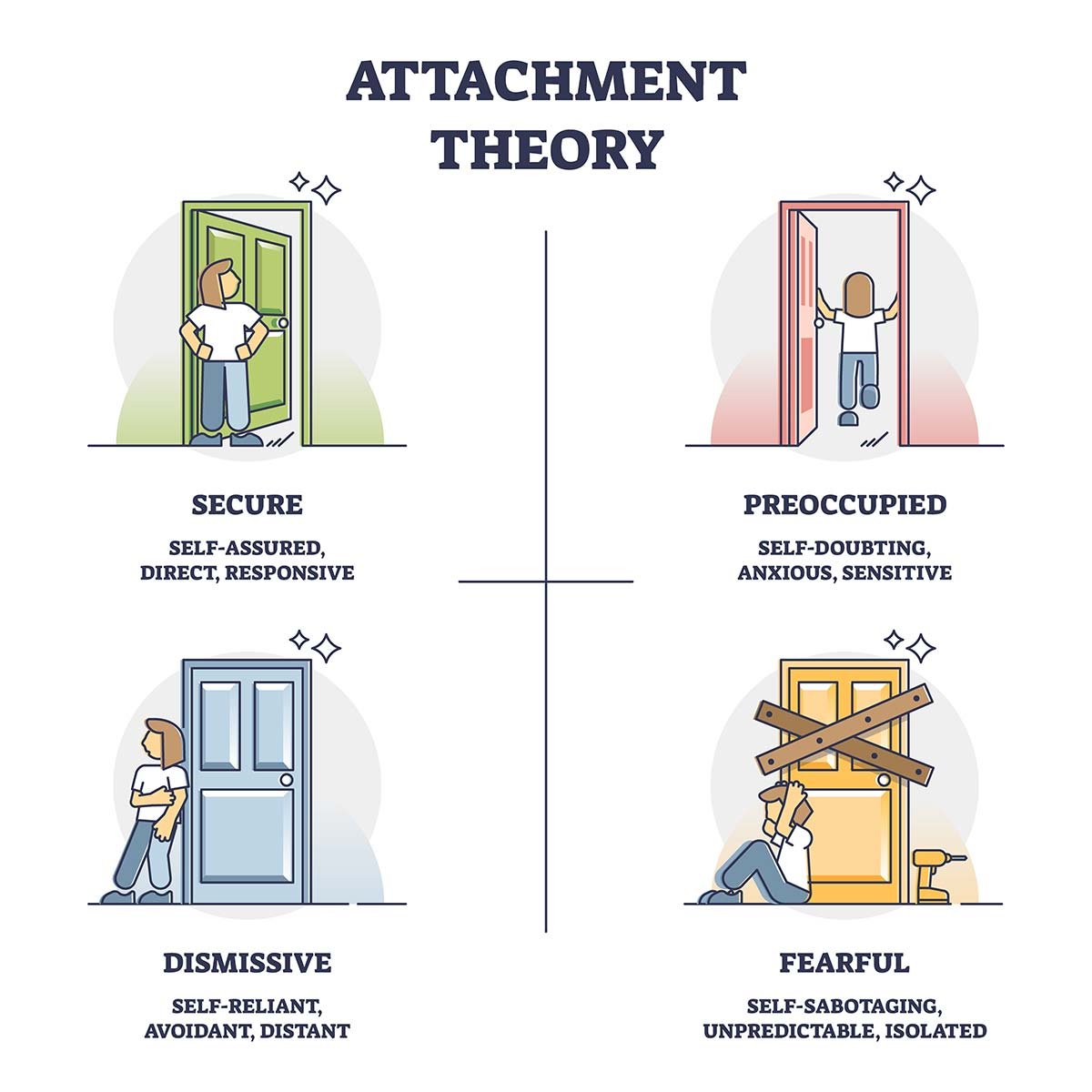
In humans, the behavioral attachment system does not conclude in infancy or even childhood. Instead, it is active throughout the lifespan, with individuals gaining comfort from physical and mental representations of significant others (Bowlby, 1969).
There appears to be a continuity between early attachment styles and the quality of later adult romantic relationships.
This idea is based on the internal working model, where an infant’s primary attachment forms a model (template) for future relationships.
Adult Attachment Styles
Adult attachment styles describe people’s comfort and confidence in close relationships, fear of rejection and yearning for intimacy, and preference for self-sufficiency or interpersonal distance.
Attachment styles comprise cognitions relating to both the self (‘Am I worthy of love’) and others (‘Can I depend on others during times of stress’).
Adult attachment styles derived from past relationship histories are conceptualized as internal working models.
Here, individuals can hold either a positive or negative belief of self and a positive or negative belief of others, thus resulting in one of four possible adult attachment styles.
The model of others can also be conceptualized as the avoidant dimension of attachment, which corresponds to the level of discomfort a person feels regarding psychological intimacy and dependency.
Alternatively, the model of self can be conceptualized as the anxiety dimension of attachment, relating to beliefs about self-worth and whether or not one will be accepted or rejected by others (Collins & Allard, 2001).
Bartholomew and Horowitz proposed four adult attachment styles regarding working models of self and others, including secure, dismissive, preoccupied, and fearful.
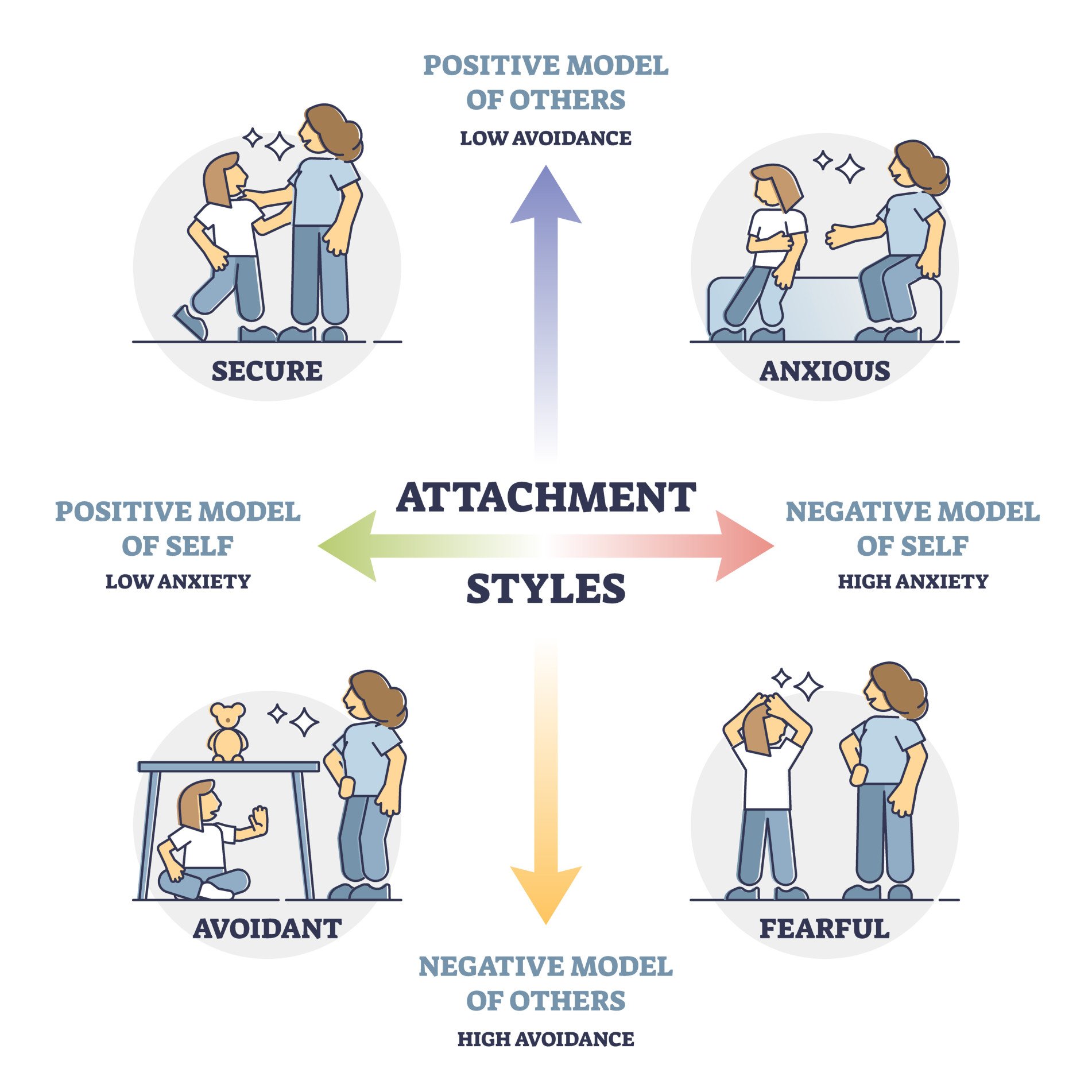
Secure Attachment Characteristics
Securely attached adults tend to hold positive self-images and positive images of others, meaning that they have both a sense of worthiness and an expectation that other people are generally accepting and responsive.
As Children
Secure attachment occurs because the mother meets the emotional needs of the infant.
Children with a secure attachment use their mother as a safe base to explore their environment. They are moderately distressed when their mother leaves the room (separation anxiety) and seek contact with their mother when she returns.
They also show moderate stranger anxiety; they show some distress when approached by a stranger.
As Adults
Adults who demonstrate a secure attachment style value relationships and affirm the impact of relationships on their personalities.
They display a readiness to recall and discuss attachments that suggest much reflection regarding previous relationships.
Secure adults display openness regarding expressing emotions and thoughts with others and are comfortable with depending on others for help while also being comfortable with others depending on them (Cassidy, 1994).
Notably, many secure adults may, in fact, experience negative attachment-related events, yet they can objectively assess people and events and assign a positive value to relationships in general.
Secure lovers characterized their most important romantic relationships as happy and trusting. They can support their partners despite the partners’ faults.
Their relationships also tend to last longer. Secure lovers believe that although romantic feelings may wax and wane, romantic love will never fade.
Through the statistical analysis, secure lovers were found to have had warmer relationships with their parents during childhood.
Preoccupied Attachment Characteristics
Individuals with a preoccupied attachment (called anxious when referring to children) hold a negative self-image and a positive image of others, meaning that they have a sense of unworthiness but generally evaluate others positively.
As such, they strive for self-acceptance by attempting to gain approval and validation from their relationships with significant others. They also require higher levels of contact and intimacy from relationships with others.
As Children
Children with this type of attachment are clingy to their mother in a new situation and are not willing to explore – suggesting that they do not have trust in her.
They are extremely distressed when separated from their mother. When the mother returns, they are pleased to see her and go to her for comfort, but they cannot be comforted and may show signs of anger towards her.
This type of attachment style occurs because the mother sometimes meets the infant’s needs and sometimes ignores their emotional needs, i.e., the mother’s behavior is inconsistent.
As Adults
Such individuals crave intimacy but remain anxious about whether other romantic partners will meet their emotional needs. Autonomy and independence can make them feel anxious.
Additionally, they are preoccupied with dependency on their own parents and still actively struggle to please them.
In addition, they can become distressed should they interpret recognition and value from others as being insincere or failing to meet an appropriate level of responsiveness.
Their attachment system is prone to hyperactivation during times of stress, emotions can become amplified, and overdependence on others is increased (Mikulincer & Shaver, 2003).
Preoccupied lovers characterize their most important romantic relationships by obsession, desire for reciprocation and union, emotional highs and lows, and extreme sexual attraction and jealousy.
Preoccupied lovers often believe that it is easy for them to fall in love, yet they also claim that unfading love is difficult to find.
Compared with secure lovers, preoccupied lovers report colder relationships with their parents during childhood.
Anxious attachment is also known as insecure resistant or anxious ambivalent.
Dismissive Attachment Characteristics
Dismissive attachment style is demonstrated by adults with a positive self-image and a negative image of others. Their internal working model is based on an avoidant attachment established during infancy.
As Children
Children with an avoidant attachment do not use the mother as a safe base; they are not distressed on separation from their caregiver and are not joyful when the mother returns. They show little stranger anxiety.
This type of attachment occurs because the mother ignores the emotional needs of the infant.
As Adults
They prefer to avoid close relationships and intimacy with others to maintain a sense of independence and invulnerability. This means they struggle with intimacy and value autonomy and self-reliance (Cassidy, 1994).
Dismissive-avoidant adults deny experiencing distress associated with relationships and downplay the importance of attachment in general, viewing other people as untrustworthy.
According to Dr. Julie Smith, a clinical psychologist, these are the signs of an avoidant attachment style in adult relationships:
- When your partner seeks intimacy with you, the barriers go up. The more they try to get close, the more you pull back.
- You hold back on starting new relationships because trusting people is so hard.
- You sometimes end relationships to gain a sense of freedom.
- You keep your partner at arm’s length emotionally because it feels safer, but they often accuse you of being distant.
Dismissive lovers are characterized by fear of intimacy, emotional highs and lows, and jealousy. They are often unsure of their feelings toward their romantic partner, believing that romantic love can rarely last and that it is hard for them to fall in love (Hazan & Shaver, 1987).
Proximity seeking is appraised as unlikely to alleviate distress resulting in deliberate deactivation of the attachment system, inhibition of the quest for support, and commitment to handling distress alone, especially distress arising from the failure of the attachment figure to be available and responsive (Mikulincer & Shaver, 2003).
Dismissive individuals have learned to suppress their emotions at the behavioral level, although they still experience emotional arousal internally (Mikulincer & Shaver, 2005).
This has negative outcomes in terms of cutting themselves off strong feelings, whether their own or others, thus influencing their experiences of romantic relationships.
Fearful Attachment Characteristics
Adults with a fearful-avoidant attachment style (also referred to as disorganized) hold a negative model of self and also a negative model of others, fearing both intimacy and autonomy.
As Children
They display attachment behaviors typical of avoidant children, becoming socially withdrawn and untrusting of others.
The behavior of a fearful-avoidant child is very disorganized, hence why it is also known as disorganized attachment.
If the child and caregiver were to be separated for any amount of time, on the reunion, the child would act conflicted. They may initially run towards their caregiver but then seem to change their mind and either run away or act out.
In the eyes of a child with a fearful avoidant attachment, their caregivers are untrustworthy.
Children with a fearful avoidant attachment are at risk of carrying these behaviors into adulthood if they do not receive support to overcome this. They may struggle to feel secure in any relationship if they do not get help for their attachment style.
As Adults
“Like dismissing avoidant, they often cope with distancing themselves from relationship partners, but unlike dismissing individuals, they continue to experience anxiety and neediness concerning their partner’s love, reliability, and trustworthiness” (Schachner, Shaver & Mikulincer, 2003, p. 248).
A fearful avoidant prefers casual relationships and may stay in the dating stage of the relationship for a prolonged period as this feels more comfortable for them.
This is not always because they want to, but because they fear getting closer to someone.
A study found that those with a fearful avoidant attachment style are likely to have more sexual partners and higher sexual compliance than other attachment styles (Favez & Tissot, 2019).
They may prefer to have more sexual partners as a way to get physically close to someone without having to also be emotionally vulnerable to them – thus meeting their need for closeness.
They could also be more sexually compliant due to having poorer boundaries and learning in childhood that their boundaries do not matter. It is important to remember that this is not the case for all fearful avoidants.
A partner with this attachment style may prefer to keep their partner at a distance so that things do not get too emotionally intense.
They may be reluctant to share too much of themselves to protect themselves from eventual hurt. If the relationship gets too deep or they are asked to share personal stories, the fearful-avoidant may shut down rapidly.
It is common for those with a fearful attachment style to have grown up in a household that is very chaotic and toxic. As such, the fearful-avoidant may expect that their romantic relationships as adults should also be chaotic.
If they are in a relationship with someone secure and calm, they may be suspicious of why this is. They may believe something must be wrong and may challenge their partner or create a problem to make the relationship more unsettled but familiar to them.
They tend to always expect something bad to happen in their relationship and will likely find any reason to damage the relationship so they do not get hurt.
They may blame or accuse their partner of things they have not done, threaten to leave the relationship, or test their partner to see if this makes them jealous. All these strategies may cause their partner to consider ending the relationship.
Attachment In Adult Relationships
Attachment styles are expectations people develop about relationships with others, and the first attachment is based on the relationship individuals had with their primary caregiver when they were infants.
Parenting Style
There is evidence that attachment styles may be transmitted between generations.
Research indicates an intergenerational continuity between adult attachment types and their children, including children adopting the parenting styles of their parents. People tend to base their parenting style on the internal working model, so the attachment type tends to be passed on through generations of a family.
Main, Kaplan, and Cassidy (1985) found a strong association between the security of the adults’ working model of attachment and that of their infants’, with a particularly strong correlation between mothers and infants (vs. fathers and infants).
Additionally, the same study also found that dismissive adults were often parents to avoidant infants. In contrast, preoccupied adults were often parents to resistant/ambivalent infants, suggesting that how adults conceptualized attachment relationships had a direct impact on how their infants attached to them.
An alternative explanation for continuity in relationships is the temperament hypothesis which argues that an infant’s temperament affects how a parent responds and so may be a determining factor in infant attachment type. The infant’s temperament may explain their issues (good or bad) with relationships in later life.
Romantic Relationships
There also appears to be a continuity between early attachment styles and the quality of later adult romantic relationships. This idea is based on the internal working model, where an infant’s primary attachment forms a model (template) for future relationships.
The internal working model influences a person’s expectation of later relationships thus affects his attitudes towards them. In other words there will be continuity between early attachment experiences and later relationships.
Adult relationships are likely to reflect early attachment style because the experience a person has with their caregiver in childhood would lead to the expectation of the same experiences in later relationships.
This is illustrated in Hazan and Shaver’s love quiz experiment. They conducted a study to collect information on participants’ early attachment styles and attitudes toward loving relationships. They found that those securely attached as infants tended to have happy, lasting relationships.
On the other hand, insecurely attached people found adult relationships more difficult, tended to divorce, and believed love was rare. This supports the idea that childhood experiences have a significant impact on people’s attitudes toward later relationships.
The continuity hypothesis is accused of being reductionist because it assumes that people who are insecurely attached as infants would have poor-quality adult relationships. This is not always the case. Researchers found plenty of people having happy relationships despite having insecure attachments. Therefore, the theory might be an oversimplification.
Brennan and Shaver (1995) discovered that there was a strong association between one’s own attachment type and the romantic partner’s attachment type, suggesting that attachment style could impact one’s choice of partners.
To be more specific, the study found that a Secure adult was most likely to be paired with another secure adult, while it was least likely for an avoidant adult to be paired with a secure adult; when a secure adult did not pair with a secure partner, he or she was more likely to have an anxious-preoccupied partner instead.
Moreover, whenever an avoidant or anxious adult did not pair with a secure partner, he or she was more likely to end up with an avoidant partner; an anxious adult was unlikely to be paired with another Anxious adult.
Adult attachment style also impacts how one behaves in romantic relationships (jealousy, trust, proximity-seeking, etc.) and how long these relationships can last, as discussed in earlier paragraphs about Hazan and Shaver’s (1987) findings.
These are, in turn, related to overall relationship satisfaction. Brennan and Shaver (1995) found that inclining toward a secure attachment type was positively correlated with one’s relationship satisfaction, whereas being either more avoidant or anxious was negatively associated with one’s relationship satisfaction.
Regarding attachment-related behaviors within relationships, being inclined to seek proximity and trust others was positively correlated with one’s relationship satisfaction.
Being self-reliant, ambivalent, jealous, clingy, easily frustrated towards one’s partner, or insecure is generally negatively correlated with one’s relationship satisfaction.
The attachment style and related behaviors of one’s partners were also found to impact one’s relationship satisfaction. Not surprisingly, having a Secure partner increases one’s relationship satisfaction.
However, an Avoidant partner was the only type of partner that seemed to contribute negatively towards one’s relationship satisfaction, while an Anxious partner had no significant impact in this aspect.
The partner’s inclination to seek proximity and trust others increased one’s satisfaction, while one’s partner’s ambivalence and frustration towards oneself decreased one’s satisfaction.
Mental Health
A new study published in the British Journal of Clinical Psychology sheds light on how our attachment styles affect our mental health and behaviors during difficult times like the COVID-19 pandemic.
Using advanced statistical techniques, researchers found that people with insecure attachment styles (especially anxious and fearful-avoidant attachments) suffered more depression, anxiety, and loneliness than their securely attached peers.
The researchers surveyed over 1300 UK adults at two time points between April and August 2020 to understand connections between attachment styles, adherence to social distancing guidelines, and mental health. They used cutting-edge causal modeling methods to estimate the likely causal effects.
The results showed that anxious and fearful-avoidant participants had around 5-6% higher depression and anxiety, and were 17-18% lonelier than secure individuals.
Over time, they maintained these elevated mental health symptoms while secure participants’ levels decreased. Greater loneliness explains the poorer mental health of insecure groups.
Avoidant participants were less likely to follow social distancing rules than secure individuals, although the effect size was small. Attachment style did not predict mental health changes from timepoints 1 to 2.
The takeaway?
Our attachment style is a risk factor for worse mental health crises during difficult collective experiences like lockdowns. Insecure individuals are more prone to loneliness driving their anxiety and depression.
The study highlights the need for targeted interventions to alleviate loneliness and promote security.
A limitation is the use of categorical attachment measures, but the advanced statistics provide compelling evidence attachment causally influences our mental health and behaviors during COVID-19.
Internal Working Models
- The social and emotional responses of the primary caregiver (usually a parent) provide the infant with information about the world and other people and how they view themselves as individuals.
- For example, the extent to which an individual perceives himself/herself as worthy of love and care and information regarding the availability and reliability of others.
- John Bowlby (1969) referred to this knowledge as an internal working model, which begins as a mental and emotional representation of the infant’s first attachment relationship and forms the basis of an individual’s attachment style.
- Romantic relationships are likely to reflect early attachment style because the experience a person has with their caregiver in childhood would lead to the expectation of the same experiences in later relationships, such as parents, friends, and romantic partners (Bartholomew and Horowitz, 1991)
- However, other researchers have proposed that rather than a single internal working model, which is generalized across relationships, each type of relationship comprises a different working model. This means a person could be securely attached to their parents but insecurely attached in romantic relationships.
How Attachment Style Is Measured
Children: Ainsworth’s Strange Situation
Ainsworth proposed the ‘sensitivity hypothesis,’ which states that the more responsive the mother is to the infant during their early months, the more secure their attachment will be.
To test this, she designed the ‘Strange Situation’ to observe attachment security in children within the context of caregiver relationships.
The child and mother experience a range of scenarios in an unfamiliar room. The procedure involves a series of eight episodes lasting approximately 3 minutes each, whereby a mother, child, and stranger are introduced, separated, and reunited.
Mary Ainsworth classified infants into one of three attachment styles; insecure avoidant (‘A’), secure (‘B’), or insecure ambivalent (‘C’).
A fourth attachment style, disorganized, was later identified (Main & Solomon, 1990).
Each type of attachment style comprises a set of attachment behavioral strategies used to achieve proximity with the caregiver and a feeling of security.
From an evolutionary perspective, an infant’s attachment classification (A, B, or C) is an adaptive response to the characteristics of the caregiving environment.
Ainsworth’s maternal sensitivity hypothesis argues that a child’s attachment style depends on their mother’s behavior towards them.
- ‘Sensitive’ mothers are responsive to the child’s needs and respond to their moods and feelings correctly. Sensitive mothers are more likely to have securely attached children.
- In contrast, mothers who are less sensitive towards their child, for example, those who respond to the child’s needs incorrectly or who are impatient or ignore the child, are likely to have insecurely attached children.
Adult Attachment Interview
Mary Main and her colleagues developed the Adult Attachment Interview that asked for descriptions of early attachment-related events and for the adults’ sense of how these relationships and events had affected adult personalities (George, Kaplan, & Main, 1984).
It is noteworthy that the Adult Attachment Interview assessed “the security of the self in relation to attachment in its generality rather than in relation to any particular present or past relationship” (Main, Kaplan, & Cassidy, 1985).
For example, the general state of mind regarding attachment rather than how one is attached to another specific individual.
Main, Kaplan, and Cassidy (1985) analyzed adults’ responses to the Adult Attachment Interview and observed three major patterns in the way adults recounted and interpreted childhood attachment experiences and relationships in general:
- Secure (Autonomous)
- Dismissive-Avoidant Attachment
- Preoccupied (Anxious) Attachment
Attachment Through Life
Attachment theory, developed by Bowlby to explain emotional bonding between infants and caregivers, has implications for understanding romantic relationships.
According to John Bowlby (1969), later relationships are likely to be a continuation of early attachment styles (secure and insecure) because the behavior of the infant’s primary attachment figure promotes an internal working model of relationships, which leads the infant to expect the same in later relationships.
In other words, there will be continuity between early attachment experiences and later relationships. This is known as the continuity hypothesis.
According to the continuity hypothesis, experiences with childhood attachment figures are retained over time and used to guide perceptions of the social world and future interactions with others.
However, there is evidence that attachment styles are fluid and demonstrate fluctuations across the lifespan (Waters, Weinfield, & Hamilton, 2000).
Therefore, rather than a single internal model, generalized across relationships, each type of relationship may comprise a different working model, meaning that a person could be securely attached to their parents but insecurely attached to romantic relationships.
Researchers have proposed that working models are interconnected within a complex hierarchical structure (Collins & Read, 1994).
For example, the highest-level model comprises beliefs and expectations across all types of relationships, and lower-level models hold general rules about specific relations, such as romantic or parental, underpinned by models specific to events within a relationship with a single person.
Can Your Attachment Style Change?
In the world of attachment studies, a big question is whether our ideas about relationships are kind of like a one-size-fits-all thing, working the same way across all relationships, or if they’re specific to particular relationships. Some experts, like Kobak (1994), have explored this.
So, one way to look at it is as an “individual difference.” This means that our attachment styles, our inner guides for how we connect with people, stay pretty much the same over time. These styles are based on our experiences with people we’re close to, like parents, friends, and romantic partners. Bartholomew and Horowitz (1991) think that how we act in relationships tends to be consistent, no matter who we’re with.
On the flip side, some folks believe that our attachment styles can change depending on the type of relationship. So, instead of one all-encompassing inner model for relationships, we might have different models for different types of connections. This means that you could be feeling secure with your parents but insecure in your romantic relationships.
A study with young adults showed that people have different attachment styles for various types of relationships, like with parents, friends, and romantic partners (Caron et al., 2012).
Researchers have suggested that these inner models are like a set of Russian dolls, with a big one that covers all types of relationships and smaller ones for specific types, like romance or family. These smaller ones are built on even smaller models, like beliefs about things that happen within one relationship.
There’s evidence supporting the idea that we have multiple internal working models because people can have a lot of different thoughts and feelings about themselves and others. And, while these specific relationship models are related to our overall generalized inner models, the connection isn’t super strong.
It means that our beliefs about ourselves and our partners in one type of relationship are somewhat separate from our broader views (Cozzarelli, Hoekstra, & Bylsma, 2000).
So, in a nutshell, our general ideas about relationships cover a wide range, while our specific thoughts about certain relationships are just a piece of the bigger picture.
Additionally, it is also noteworthy that one’s attachment style may alter over time as well.
Another interesting thing is that your attachment style can change over time. In different studies, about 70% of people had relatively stable attachment styles, while the other 30% were more flexible.
Baldwin and Fehr (1995) discovered that 30% of adults changed their attachment styles fairly quickly, sometimes in as little as a week or a few months. People who initially identified as anxious-ambivalent were the most likely to change.
In a 20-year longitudinal study, Waters et al. (2000) conducted the Adult Attachment Interview with young adults who had participated in the Strange Situation experiment 20 years ago. They found that 72% of the participants received the same secure vs. insecure attachment classifications as they did during infancy.
The remaining participants did change in terms of attachment patterns, with the majority – though not all – of them having experienced major negative life events.
Such findings suggest that attachment style assessments should be interpreted more prudently; furthermore, there is always the possibility for change – and it need not be related to negative events, either.
Further Information
- How To Know If Your Date Has A Secure Attachment Style
- How To Move From Anxious Attachment To Secure
- BPS Article- Overrated: The predictive power of attachment
- Scoring for the Strange Situation
- A theoretical review of the infant-mother relationship
- Ainsworth Strange Situation
- Cross-cultural Patterns of Attachment: A Meta-Analysis of the Strange Situation
- How Attachment Style Changes Through Multiple Decades Of Life
References
Ainsworth, M. D. S., Blehar, M. C., Waters, E., & Wall, S. (1978). Patterns of attachment: A psychological study of the strange situation. Lawrence Erlbaum.
Baldwin, M.W., & Fehr, B. (1995). On the instability of attachment style ratings. Personal Relationships, 2, 247-261.
Bartholomew, K., & Horowitz, L.M. (1991). Attachment Styles Among Young Adults: A Test of a Four-Category Model. Journal of Personality and Social Psychology, 61 (2), 226–244.
Bowlby, J. (1969). Attachment and Loss: Volume I. Attachment. London: Hogarth Press.
Brennan, K. A., Clark, C. L., & Shaver, P. R. (1998). Self-report measurement of adult attachment: An integrative overview. In J. A. Simpson & W. S. Rholes (Eds.), Attachment theory and close relationships (p. 46–76). The Guilford Press.
Brennan, K. A., & Shaver, P. R. (1995). Dimensions of adult attachment, affect regulation, and romantic relationship functioning. Personality and Social Psychology Bulletin, 21 (3), 267–283.
Caron, A., Lafontaine, M., Bureau, J., Levesque, C., and Johnson, S.M. (2012). Comparisons of Close Relationships: An Evaluation of Relationship Quality and Patterns of Attachment to Parents, Friends, and Romantic Partners in Young Adults. Canadian Journal of Behavioural Science, 44 (4), 245-256.
Collins, N. L., & Read, S. J. (1994). Cognitive representations of adult attachment: The structure and function of working models. In K. Bartholomew & D. Perlman (Eds.) Advances in personal relationships, Vol. 5: Attachment processes in adulthood (pp. 53-90). London: Jessica Kingsley.
George, C., Kaplan, N., & Main, M. (1984). The Adult Attachment Interview. Unpublished manuscript, University of California at Berkeley.
Harlow, H. (1958). The nature of love. American Psychologist, 13, 573-685.
Hazan, C., & Shaver, P. (1987). Romantic love conceptualized as an attachment process. Journal of Personality and Social Psychology, 52 (3), 511–524.
Main, M., Kaplan, N., & Cassidy, J. (1985). Security in infancy, childhood and adulthood: A move to the level of representation. In I. Bretherton & E. Waters (Eds.), Growing points of attachment theory and research. Monographs of the Society for Research in Child Development, 50 (1-2), 66-104.
Main, M., & Solomon, J. (1986). Discovery of an insecure-disorganized/disoriented attachment pattern. In T. B. Brazelton & M. W. Yogman (Eds.), Affective development in infancy . Ablex Publishing.
Vowels, L. M., Vowels, M. J., Carnelley, K. B., Millings, A., & Gibson‐Miller, J. (2023). Toward a causal link between attachment styles and mental health during the COVID‐19 pandemic. British Journal of Clinical Psychology.
Waters, E., Merrick, S., Treboux, D., Crowell, J., & Albersheim, L. (2000). Attachment security in infancy and early adulthood: A twenty-year longitudinal study. Child Development, 71 (3), 684-689.
Waters, E., Weinfield, N. S., & Hamilton, C. E. (2000). The stability of attachment security from infancy to adolescence and early adulthood: General discussion. Child Development, 71 (3), 703-706.
